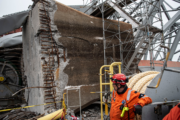WASHINGTON — Calling Metro’s state of disrepair a crisis, the transit agency’s leaders announced a year of repairs that will take entire stretches of track out of commission for weeks at a time and will require round-the-clock single tracking for other portions of the rail system in an effort to correct years of neglected maintenance.
“This system will never be new again,” said General Manager Paul Wiedefeld. “This is focused on the safety and reliability.”
Riders on all lines will be affected by the repairs over the next year, Wiedefeld announced Friday morning. He wants to finalize the plan, which he called a draft, by May 16 and begin work in June.
The announcement comes three days after federal transportation investigators blamed poor maintenance on an electrical fire that filled a Yellow Line tunnel with smoke, ultimately killing one commuters and sending dozens more to the hospital.
The SafeTrack work plan includes 15 “safety surges” that will involve trains sharing a single track for weeks at a time on some stretches, as well as continuous shutdowns of some sections of track.
In addition to delays, lines with single-tracking are also expected to have fewer trains than usual running during the workweek. The system would also close two hours earlier, at 12 a.m., on weekends in order to increase the number of hours per day that workers have access to the tracks.
Most of the repairs will take place in the Maryland and Norther Virginia suburbs but the service reductions will ripple throughout the system.
The first surge repairs will target the stretch of track between Franconia/Springfield and Van Dorn Street and would require inbound and outbound trains to share a single track from June 5 to 19. Next up: continuous single-tracking between Greenbelt and College Park from June 20 through July 13.
The system will shut down at midnight seven days a week beginning Friday, June 3. Repair work, which now begins at 10 p.m. weeknights, will start at 8 p.m.
“We need to do something different, and dramatically different,” Wiedefeld said, comparing the plan to a “military operation.” He said that work will be done on tunnel drainage, power cables, the third rail, rail ties, signage — “every part of the system.”
The work is set to finish May 8, 2017. By the time it’s done, according to the plan, 48,000 wooden ties and 36,000 fasteners will be replaced; 87,000 linear feet of drains will be cleared and 12,000 insulators will be replaced.
In terms of the number of riders affected, the biggest impact will come between Oct. 9 and Nov. 2, when the Red Line will shut down between NoMa-Gallaudet and Fort Totten, which will affect 108,000 weekday trips.
Wiedefeld has called this a “draft” plan, open for feedback from the region especially with regard to mitigating the traffic impact as commuters inevitably swap Metro for their cars. He said that Metro would consult with the human resources departments of public and private employers. Forty to 50 dedicated buses would be available to help shuttle riders along segments with reduced or no service.
Last week, Wiedefeld said riders would have to make sacrifices and to expect significant service reductions while repairs are underway.
Here is the scheduled list of track shutdowns, according to Metro’s rebuilding plan:
- July 5 — 12 from Reagan National Airport to Braddock Road
- July 12-19 from Reagan National Airport to Pentagon City
- Aug. 20 to Sept. 6 from Eastern Market to Minnesota/Benning
- Oct. 9 to Nov. 2 from NoMa/Gallaudet to Fort Totten
- Dec. 6-24 from Pentagon to Rosslyn
Here is the scheduled list of continuous single tracking, according to Metro’s rebuilding plan:
- June 4-19 from Franconia/Springfield to Van Dorn Street
- June 20 to July 3 from Greenbelt to College Park
- July 20-31 from Greenbelt to College Park
- Aug. 1-8 from Takoma to Silver Spring
- Aug. 9-19 from Shady Grove to Twinbrook
- Sept. 9 to Oct. 21 from Vienna to West Falls Church
- Nov. 2-12 from West Falls Church to East Falls Church
- Nov. 12 to Dec. 5 from East Falls Church to Ballston
- March 6-14 West Falls Church to East Falls Church
- April 16 to May 8 from Braddock to Huntington/Van Dorn Street
“The goal here was not to eliminate any service,” he said, because some riders have no other options.
Jack Evans, chair of Metro’s board of directors and a D.C. Councilmember, said the board supports Wiedefeld’s plan.
He asked riders and the whole region to “bear with us,” acknowledging that the work would make the situation “more inconvenient than it is now.”
“We cannot continue as we are,” he said, referring to a recent rash of incidents on Metro.
“We need track time,” he said.
The plan says that Metro is up and running 85 percent of the week, and of the remaining time, 5 percent was eaten up by setting up and taking down equipment for track work.
Wiedefeld said that that simply wasn’t enough: “We cannot keep up.”
Evans called the current situation “a crisis,” and added that the population of D.C., is projected to surpass 1 million in the next 20 years or less. And residents need a way to get around “that isn’t cars,” Evans said.
He predicted that once the repairs are completed, ridership will rebound. Metro ridership has declined in recent years. Still, more than 700,000 riders take the transit service daily and it remains the backbone of the region’s transportation network.
The total cost of the repairs is not clear but Evans has suggested previously that it could cost $1 billion.
Wiedefeld didn’t said that budgets are made two years out, and that Metro might need to borrow the money to cover the cost. He added, however, that the increased productivity would save money. Asked whether the cost would run into the billions, he thought, then replied, “No.”
Stay up to date with Metro track work on the transit agency’s service advisories page.
WTOP’s Amanda Iacone contributed to this report.






